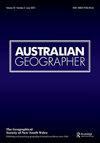防洪结构对泛滥平原生态系统的影响:澳大利亚和法国的三个案例研究综述
IF 2
2区 社会学
Q2 GEOGRAPHY
引用次数: 1
摘要
摘要本研究关注防洪结构对“人性化”和“自然”泛滥平原生态系统的物理影响。前者构成肥沃、排水良好和发达的地表。后者主要是位于宽阔低洼泛滥平原回水区的退化湿地。调查了三条河流:澳大利亚新南威尔士州的霍克斯伯里-尼泊尔河和麦克利河,以及法国南部的杜朗斯河。分析了它们的泛滥平原、防洪工程和泛滥平原生态系统,以及它们在泛滥平原、开发和退化方面的地点和时间差异。洪泛平原的保护旨在扭转湿地退化,提高生物多样性和可持续性,并保护发达的洪泛平原。这项研究讨论了我们对生态系统的生物物理知识的差距,以及缺乏退化的生态指标。它还考虑到缺乏关于独特的、针对地点和时间的生物物理系统的社会经济价值的数据。只有解决这些不足之处,才能充分理解生态系统的价值。这样,成本效益高的管理可能成为可能。这些知识差距导致了泛滥平原管理的许多问题,当人口增加和全球变暖的额外影响变得明显时,这些问题可能会增加。本文章由计算机程序翻译,如有差异,请以英文原文为准。
The impacts of flood-mitigation structures on floodplain ecosystems: a review of three case studies from Australia and France
ABSTRACT This study is concerned with the physical impacts of flood-mitigation structures on ‘humanised’ and ‘natural’ floodplain ecosystems. The former constitute fertile, well drained and developed surfaces. The latter are mainly degraded wetland areas located in the backwater zones of wide, low-lying floodplains. Three rivers are investigated: the Hawkesbury–Nepean and the Macleay Rivers in New South Wales, Australia and the Durance River in southern France. Their floodplains, flood-mitigation works and floodplain ecosystems are analysed, together with site- and time-dependent differences in their floodplains, their exploitation and their degradation. Conservation of floodplains seeks to reverse wetland degradation, and to increase biodiversity and sustainability, as well as preserving developed floodplains. This study discusses gaps in our biophysical knowledge of ecosystems and the absence of ecological indicators of degradation. It also considers the lack of data on socio-economic values for what are unique, site- and time-specific, biophysical systems. Only when such inadequacies are addressed will the values of ecosystems be fully understood. Then cost-effective management might be possible. These knowledge gaps contribute to the many problems of floodplain management, which are likely to increase when the additional impacts of population increase and global warming become apparent.
求助全文
通过发布文献求助,成功后即可免费获取论文全文。
去求助
来源期刊

Australian Geographer
GEOGRAPHY-
CiteScore
4.10
自引率
8.30%
发文量
33
期刊介绍:
Australian Geographer was founded in 1928 and is the nation"s oldest geographical journal. It is a high standard, refereed general geography journal covering all aspects of the discipline, both human and physical. While papers concerning any aspect of geography are considered for publication, the journal focuses primarily on two areas of research: •Australia and its world region, including developments, issues and policies in Australia, the western Pacific, the Indian Ocean, Asia and Antarctica. •Environmental studies, particularly the biophysical environment and human interaction with it.
 求助内容:
求助内容: 应助结果提醒方式:
应助结果提醒方式:


